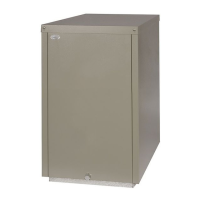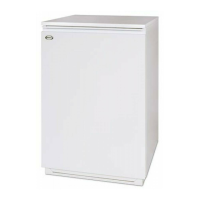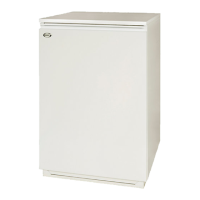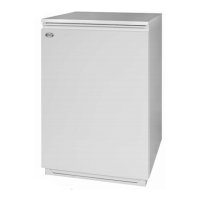Combi 90 Outdoor Module
6
3 - GENERAL BOILER INFORMATION
The Outdoor Module is supplied in one pack, with the
burner and control panel factory fitted. The flue
terminal and wire guard are supplied loose (inside the
carton) for fitting on site.
Installation of a Combi boiler must be in accordance
with the following recommendations:-
a Building Regulations for England and Wales,
and the Building Standards for Scotland issued
by the Department of the Environment and any
local Byelaws etc.
b Model and local Water Undertaking Byelaws.
c Applicable Control of Pollution Regulations.
d The following OFTEC requirements:-
OFS T100 Polythene oil storage tanks for
distillate fuels.
OFS T200 Fuel oil storage tanks and tank
bunds for use with distillate fuels,
lubrication oils and waste oils.
Further information may be obtained from the
OFTEC Technical Information Book 3
(Installation requirements for oil fired boilers
and oil storage tanks).
The installation should also be in accordance with the
latest edition of the following British Standard Codes
of Practice:-
BS 715 Metal flue pipes, fittings, terminals
and accessories.
BS 799:5 Oil storage tanks.
BS 1181 Clay flue linings and flue terminals.
BS 4543:3 Factory made insulated chimneys for
oil fired appliances.
BS 4876 Performance requirements for oil
burning appliances.
BS 5410:1 Code of Practice for oil firing appliances.
BS 5449 Forced circulation hot water systems.
BS 7593 Code of Practice for treatment of
water in heating systems.
BS 7671 Requirements for electrical
installations, IEE Wiring Regulations.
Failure to install and commission appliances
correctly may invalidate the boiler warranty.
3.4
Fuel supply
Regulations to comply with
3.3
3.5
Method of operation
Delivery
3.2
For details of the fuel supply, refer to Section 3.4 in
the main Installation and Servicing instructions
supplied with the boiler.
Once the boiler is switched on it will always provide
domestic hot water upon demand. The timer only
controls the operating times of the central heating.
When central heating is not required, the timer switch
should be set to OFF.
Domestic hot water supply always takes priority over
central heating. If a demand for hot water occurs
during a period of central heating, the boiler mode will
automatically change to provide hot water until the
demand ceases. This interruption in the central heating
only lasts for as long as hot water is required and
should not be noticed by the User.
Central Heating Mode - If there is a call for heat, i.e. the
timer and room thermostat (if fitted) are calling for heat,
the pump will start to circulate the central heating water
and the burner will light. When the temperature in the
boiler reaches that set on the boiler thermostat, the burner
is turned off. The pump continues to run, circulating
water around the system, for as long as both the timer and
room thermostat (if fitted) are calling for heat. As the
heating system water cools, the temperature drop is
detected by the boiler thermostat and the burner is
automatically restarted for the cycle to continue until
either the timer or room thermostat stops calling for heat.
The burner and pump are then turned off.
Domestic Hot Water Mode - When a demand for hot
water (by opening a hot tap, etc.) is sensed by the diverter
valve flow switches, the pump starts and the water in the
boiler is diverted through the domestic hot water heat
exchanger, heating the incoming mains water. The hot
water produced is mixed in the thermostatic blending
valve with incoming mains water to automatically ensure
that the temperature does not exceed 65°C.
Note: For optimum performance it is recommended that
the thermostatic blending valve is set to provide a hot
water temperature at the outlets between 45 and 50°C.
Note: If the water in the boiler is already up to
temperature, there will be a delay before the burner
starts to maintain the water temperature in the boiler.
